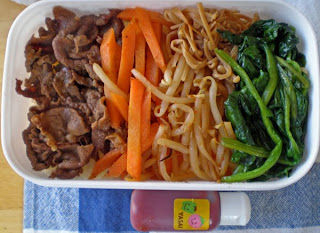
My rice isn't confused, it's just mixed up.
Bibimbap is a dish I fell in love with in when I was living in Korea. Beloved of schoolchildren and English teachers across the country, it's a one-bowl dish of rice topped with various vegetables, beef, gochujang, and a fried egg. It can be served in a stainless steel bowl or a stone crock that's been heated on a burner - in which case it's called dolsot bibimbap. In Korea, the town of Jeon Ju is famous for it's bibimbap, for reasons that are currently obscure to me.
If you haven't tried Korean food before, I urge you to start with this dish. A traditional Korean meal includes rice, kimchi, a stew (such as deonjangjigae) and several side dishes (panchan) that are seasonal, and prepared on the whim of the cook. These panchan are often made in advance, and kept in the fridge for several day's worth of meals. The rice and stew are made fresh as needed for meals.
Bibimbap, on the other hand, is much simpler to prepare and serve. You can use almost any vegetables you have on hand, and while beef is traditional, there's no reason you couldn't use ground chicken or pork either. If you can't find gochujang, you can use any thick chili sauce (sri racha comes to mind) ; or, if you're afraid of the spice, barbecue or tonkatsu sauce could be used. There's a bit on bibimbap history here, but I suspect its current popularity as a dish in Korea is due to its usefulness in using up all the odds and ends of panchan lurking in the fridge.
Traditional bibimbap includes vegetables that might be hard to find outside of Korea (fern brake, anyone?), so I make it with whatever vegetables are on hand and cheap. Last night, that included carrot, spinach (100 yen a bunch! practically free!), enoki mushrooms, and bean sprouts. Since I didn't have several Lock and Lock containers of panchan in the fridge, I prepped the veg and meat individually while the rice cooked. All told, it took about a half hour to put together - and about ten minutes to eat! There were enough leftovers to make a bento for lunch the next day as well.
You'll need: (for two people, plus maybe a bento leftover)
1 bunch of spinach, cleaned and trimmed.
1 big carrot, peeled and julienned.
1 bunch of enoki mushrooms, bottoms trimmed off (or about 1 cup of sliced mushrooms)
1 bag of bean sprouts, rinsed.
200-300g of ground beef/pork/chicken, depending on how much you like meat. (or make it vegetarian by using more veg - why not?)
3 cups of cooked rice.
4 Tbsp. gochujang, plus some rice vinegar for thinning.
Sesame oil, chopped garlic, soy sauce, chili flakes to taste
First put your rice on to cook. While it's bubbling away, get out your fry pan and heat it up. Add some (1 tsp-ish) sesame oil, and then your carrots. Fry over med-high heat until you think they're tender enough, then tip them out onto a big clear plate you've kept to the side. Push the carrots into a pile (tongs help for this), and put the pan back onto the heat. Next, add some more sesame oil, some chopped garlic and spinach, and saute until the spinach is wilted. Tip that out next to the carrots, and add the bean sprouts to the pan. I usually add a tablespoon or so of soy sauce and chili flakes to my bean sprouts, but this is optional. When they're limp, tip them out next to the carrots and spinach, and cook the mushrooms similarly. When the vegetables are all done, cook the meat with another tablespoon or so of soy sauce and sesame oil. By the time the meat is well browned, your rice should be nearing completion.
To assemble the dish, you'll need two deep bowls - one for each person. Add a cup or so of cooked rice to the bottom of each bowl, then top with the meat and vegetables, each in its own little pile around the bowl. Then, in a smaller bowl, thin the gochujang with 1-2 tablespoons of rice vinegar - this will make it easier to mix around in the bowl. Dollop a good spoonful of the thinned gochujang in the middle of your bibimbap, so it looks like a red sun in the middle of a vegetable sky. (If you like it more spicy, add more; if you like it less spicy, add less.) At this point, you can top it with a fried egg and flakes of nori, but I usually leave it here, as the meat is good enough for me.
Then you take it to the table, and stir it all in together, ruining your fine arrangement.
 Bento!
Bento!


























